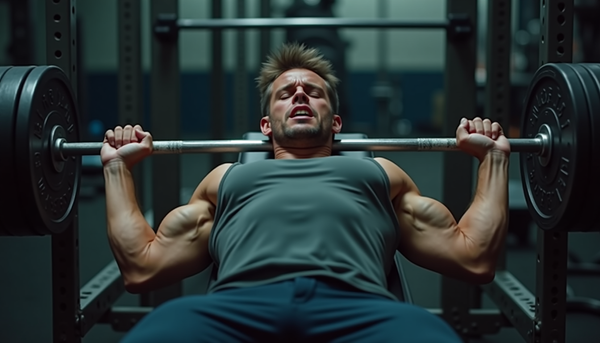Why Your "Cardio" Is Sabotaging Your Deadlift

Let me tell you about the time I almost ruined my meet prep because I listened to a fitness influencer.
Three weeks out from nationals, I was hitting PRs in training. Everything felt dialed in. Then I made the mistake of watching some Instagram "expert" preach about how "real athletes" do conditioning. Next thing I know, I'm doing burpee-to-box-jump circuits thinking I'm being smart about my cardio.
Two weeks later? My squat felt like I was moving underwater, and my deadlift... well, let's just say the bar wasn't the only thing that died that day.
Here's what nobody wants to tell you about conditioning as a strength athlete: most of what you see online is designed to sell supplements and programs, not actually make you stronger.
The Conditioning Con Game
Walk into any commercial gym and watch what people call "conditioning." You'll see folks doing jumping jacks between kettlebell swings, calling it metabolic conditioning. You'll see powerlifters doing CrossFit WODs because someone told them they need to "improve their work capacity."
It's all backwards.
The fitness industry has convinced us that if we're not gasping for air and drenched in sweat, we're not working hard enough. But here's the thing - conditioning isn't about suffering. It's about being prepared for the specific demands of your sport.
When I was competing, my sport demanded that I walk up to a loaded barbell, take a deep breath, and move as much weight as humanly possible for about 3-5 seconds. That's it. No jumping. No burpees. No "functional movement patterns" that look like someone having a seizure.
So why was I training my cardiovascular system like I was preparing for American Ninja Warrior?
Fitness vs. Conditioning: Why It Matters
This is where most people get lost. They think fitness and conditioning are the same thing. They're not.
Fitness is general. It's your body's overall capacity to handle physical stress. Think of it as your body's operating system - the baseline stuff that keeps you healthy and functional.
Conditioning is specific. It's your preparation for a particular task or environment. If fitness is your operating system, conditioning is the specialized software you need to excel at your chosen sport.
A marathon runner and a powerlifter might both be incredibly fit, but they're conditioned for completely different demands. The marathoner's heart can pump oxygenated blood efficiently for hours. The powerlifter's nervous system can recruit maximum motor units under extreme load.
Put that marathoner under a 600lb squat, and their cardiovascular fitness won't help them much. Put the powerlifter at mile 20 of a marathon, and their ability to recruit fast-twitch fibers becomes pretty irrelevant.
Here's what this means practically: your conditioning should look like your sport, not like what gets the most likes on Instagram.
The Cardio Confusion
But wait - doesn't everyone need some cardiovascular training?
Absolutely. But not for the reasons most people think.
I see strength athletes doing these insane HIIT circuits thinking they're being sport-specific. "I need to improve my anaerobic capacity for those heavy singles!" they say. Meanwhile, they're doing 20-minute workouts that have them redlining their heart rate for longer than they'd spend lifting in an entire training session.
Here's the reality: every time you walk up to a heavy squat or deadlift, you're already doing high-intensity interval training. Your heart rate spikes, you exert maximum effort for a few seconds, then you rest for 3-5 minutes. Sound familiar?
You don't need more high-intensity work. You need the opposite.
Think about it logically. What's actually limiting you during a heavy lifting session? Usually, it's not your ability to produce force - it's your ability to recover between sets. That 3-4 minute rest period between heavy pulls? That's when your aerobic system is working overtime to clear metabolic waste and restock your muscles with the good stuff.
Improving your aerobic capacity helps you recover faster between sets and between workouts. It's not sexy, but it works.
What Actually Works (And What Doesn't)
After 15 years of competing and another 8 of coaching, here's what I've learned works for strength athletes:
Skip the Instagram Workouts
Those "metabolic finishers" and circuit training sessions? They're just adding stress without meaningful benefit. You're already getting plenty of high-intensity stimulus from your lifting. Adding more just eats into your recovery capacity.
I had a client who was stuck on his bench press for months. Turns out he was doing these brutal "conditioning" circuits three times a week on top of his lifting. We dropped those, replaced them with easy bike rides, and he added 20 pounds to his bench in 6 weeks.
Embrace Boring Cardio
The most effective cardiovascular training for strength athletes is also the most boring: steady-state, moderate-intensity aerobic work.
I know, I know. It doesn't feel hardcore. It doesn't make for great social media content. But it works.
Here's what I recommend to my athletes:
The Conversational Pace Protocol: 30-45 minutes at an intensity where you can hold a normal conversation. If you're breathing too hard to chat, slow down. If you feel like you're barely working, speed up slightly.
The 130-150 Rule: Keep your heart rate between 130-150 BPM for the entire session. No spikes, no valleys. Just steady, consistent work.
Off-Legs Training: Bike, rowing machine, or ski erg. Your legs take enough beating from squats and deadlifts. Give them a break.
The Protocols That Actually Work
Here are three approaches I use with my athletes, depending on their schedule and preferences:
Protocol 1 - Steady State (My Personal Favorite):
- 30-45 minutes on a bike or rower
- Heart rate 130-150 BPM throughout
- Do this 3-4 times per week
- You should feel refreshed afterward, not destroyed
Protocol 2 - Aerobic Intervals:
- 30 seconds work, 15 seconds easy pace
- Repeat for 30-45 minutes total
- The "work" should still be conversational pace
- The "rest" should be very easy
Protocol 3 - Tempo Intervals (For Time-Crunched Athletes):
- 15 seconds slightly harder effort, 45 seconds easy
- 20-30 minutes total
- The hard portions should be sustainable - not all-out sprints
Notice what's missing? Burpees. Box jumps. Anything that involves jumping around like a caffeinated squirrel.
The Running Question
People always ask me about running. Here's my honest take: for most strength athletes, the risk-reward ratio of running sucks.
Running beats up your joints, especially if you're carrying the muscle mass most serious lifters have. It's higher impact than necessary. And unless you're specifically training to run, there are better options.
If you absolutely love running and won't do cardio any other way, fine. But keep it short and don't make it your primary form of cardiovascular training.
But What About Work Capacity?
"But Tank," you might say, "what about improving my work capacity for those brutal squat sessions?"
Here's the thing - your work capacity for squatting improves by... squatting more. The best way to handle a 20-set squat session is to gradually work up to 20-set squat sessions, not to do circuits of mountain climbers.
Sport-specific conditioning means doing more of your sport, in the environment you'll compete in, with the demands you'll face.
For powerlifters, this might mean practicing your competition timing and handling heavy openers when you're already fatigued. For strongmen, it means actually doing the events you'll compete in, not general "strongman-like" movements.
The Recovery Reality
Here's what really changed my perspective on this whole topic: your ability to recover is finite.
Every training stress you add competes for the same recovery resources. Those HIIT circuits might make you feel like a badass, but they're stealing recovery capacity from your squat progression.
When I finally understood this - really understood it - everything clicked. I started viewing my cardiovascular training as recovery assistance, not additional stress. My strength numbers started climbing again, and I felt better day-to-day.
The Practical Stuff Nobody Talks About
Let's get real for a minute. You know what having better cardiovascular fitness actually helps with as a strength athlete?
- Walking up stairs without getting winded
- Carrying groceries without feeling like you just did a workout
- Not feeling like death after tying your shoes
- Actually having energy to play with your kids
These might not sound like performance benefits, but they are. When basic life activities don't drain your energy, you have more left for training.
Plus, and this is important - cardiovascular training is probably the most important thing you can do for your long-term health. I don't care how much you can deadlift; if your heart can't handle walking up a flight of stairs, you've got problems that go beyond your next meet.
What About the Science?
I know some of you want to see the research. There's plenty of it, and it backs up what I'm saying. But honestly? You don't need a PhD in exercise physiology to figure this out.
Try both approaches for 8 weeks each. Spend 8 weeks doing the Instagram-worthy circuits and HIIT sessions. Then spend 8 weeks doing boring, steady-state cardio.
Track your strength progress, how you feel during workouts, and how you recover between sessions. I'm confident I know which approach will win.
The Bottom Line
Here's what this all comes down to: stop making your cardiovascular training harder than it needs to be.
The fitness industry profits from convincing you that harder is always better. That if you're not suffering, you're not improving. But sometimes the most effective approach is also the simplest one.
Your conditioning should support your strength training, not compete with it. Save the intensity for your squats, deadlifts, and bench press. Let your cardio be the slow, steady foundation that helps you recover and stay healthy.
And for the love of all that's heavy, stop doing burpees between your squat sets and calling it "functional training."
Your Move
If you're ready to stop sabotaging your strength gains with misguided conditioning, here's what I want you to do:
Drop whatever circus-style "conditioning" you're currently doing. Pick one of the three protocols I outlined above. Do it consistently for 8 weeks. Track your strength progress and how you feel.
Then come back and tell me I'm wrong.
But here's the thing - you probably won't. Because once you experience what it feels like to have your cardiovascular training actually support your strength goals instead of fighting them, you'll never go back to those Instagram circuits.
At least, that's what every single one of my athletes has told me so far.
What've you got to lose? Besides maybe some social media likes on your workout videos...




